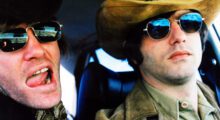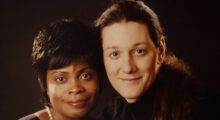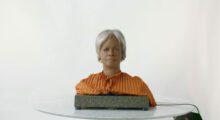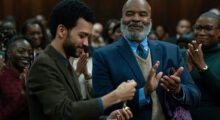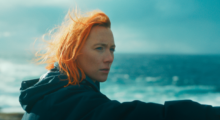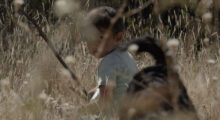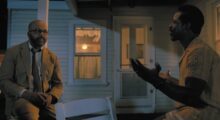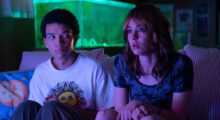Cinematographers
Interviews - Cinematographers
-
“There’s a Gritty Reality That is Undeniable”: DP David Timoner on Dig! XX

Dig!, Ondi Timoner’s 2004 documentary on The Brian Jonestown Massacre and The Dandy Warhols, remains an illuminating look at the turn-of-the-century indie rock scene in the United States. The film has been newly edited and restored and will play the 2024 Sundance Film Festival as Dig! XX to celebrate the festival’s 40th anniversary. Below, David Timoner, who shared cinematography duties with his sister Ondi and Vasco Tunes on the original Dig! walks down memory lane as he relates their ingenuity in capturing such intimate footage and how the quality of the cameras improved alongside the bands’ popularity. See all responses to our annual […]
-
“When You’re Telling a Story About the Future, the Conclusion is Itself Inconclusive”: Editor Conor McBride on Love Machina

Love Machina, the latest film by documentarian Peter Sillen (Benjamin Smoke) follows the couple Martine and Bina Rothblatt, who attempt to transfer Bina’s consciousness to a commissioned humanoid artificial intelligence to preserve their love for one another. The film is also the first feature film editor credit for Conor McBride who discusses the timeliness of the film and its subject matter, as well as how he balanced the need for the film to be simultaneously entertaining and touching. See all responses to our annual Sundance editor questionnaire here. Filmmaker: How and why did you wind up being the editor of your […]
-
“Love Machina Taps into the Lofty Idealism of the 1960s”: DP Peter Sillen on Love Machina

Martine Rothblatt and Bina Rothblatt are two futurists attempting to preserve their love forever with BINA48, a robotic face with chatbot capabilities to which the couple hopes to upload Bina’s consciousness. Their story is chronicled in director Peter Sillen’s Love Machina, a 2024 Sundance premiere. For this project, Sillen served as his own cinematographer. Below, he explains why he made that choice for the film and explains the film’s relationship to 1960s America. See all responses to our annual Sundance cinematographer interviews here. Filmmaker: How and why did you wind up being the cinematographer of your film? What were the factors […]
-
“You Live and Die by Your Crew”: DP Doug Emmett on The American Society of Magical Negroes

Riffing on the eponymous stock trope recognizable in so many American films, The American Society of Magical Negroes tells the story of Aren, the latest recruit to a secret society of magical Black people who use their powers to make the lives of white people easier. The Sundance 2024 premiere is the debut film for director Kobi Libii. The film’s cinematographer Doug Emmett has a number of recognizable credits under his belt, including The Edge of Seventeen and Sorry to Bother You. Below, he humorously recounts difficulties mounting a set three floors underground and details the inspirations behind the film’s look. See all responses to […]
-
“The Images Mostly Emerged Intuitively”: DP Yunus Roy Imer on The Outrun

In The Outrun, a London woman’s return to Scotland’s Orkney Islands as she attempts to reconcile herself with the past and her drug addictions. Based on the bestselling memoir by Amy Liptrot and directed by Nora Fingscheidt (The Unforgivable, System Crasher), the film includes on-location shooting in both London and on Orkney. Below, cinematographer Yunus Roy Imer recounts the difficulty of shooting a harsh Orkney winter during the summer and explains the various cameras and lenses he used to make sure the look of the film was always perfect. See all responses to our annual Sundance cinematographer interviews here. Filmmaker: How […]
-
“Simplicity Would Become One of Our Fundamental Rules”: DP Ximena Amann on Sujo

Sujo, the Sundance 2024 World Cinema Dramatic Competition premiere directed by Astrid Rondero and Fernanda Valadez, follows the life of a Mexican boy who is orphaned when his father, a cartel gunman, is killed. Below, cinematographer Ximena Amann, who also shot Rondero’s previous film, The Darkest Days of Us, discusses the challenges and delights of working with children and shooting in a protected natural area with minimal equipment. See all responses to our annual Sundance cinematographer interviews here. Filmmaker: How and why did you wind up being the cinematographer of your film? What were the factors and attributes that led […]
-
“I Get to Work with So Many Talented People”: DP Kevin Fletcher on It’s What’s Inside

In the Sundance 2024 Midnight premiere It’s What’s Inside, the feature debut of writer-director Greg Jardin, an uninvited guest with a mysterious suitcase derails a pre-wedding party. The film’s colorful visual palette, realized by Kevin Fletcher, echoes the high-octane nature of the plot. Below, Fletcher shares some of the influences on the film’s distinct look and extols the virtues of preparatory work. See all responses to our annual Sundance cinematographer interviews here. Filmmaker: How and why did you wind up being the cinematographer of your film? What were the factors and attributes that led to your being hired for this […]
-
“I’ve Never Had a Director Give Me a GIF as a Reference Before”: DP Cristina Dunlap on American Fiction

Music videos have been good to Cristina Dunlap. As a photography-obsessed high schooler, a chance meeting landed the L.A. native a gig shooting stills on a music video. It happened to be for Death Cab for Cutie, leading to a run of jobs with influential directors like Hiro Murai and Ace Norton. After working her way up to the role of cinematographer, a Coldplay video collaboration with Dakota Johnson led to Dunlap shooting a pair of features starring the actress, Am I OK? and Cha Cha Real Smooth, both of which premiered at the 2022 Sundance Film Festival. A music […]
-
“We Tried to Take Advantage of What We Found on Site”: DP Nicolas Canniccioni on How to Have Sex

How to Have Sex, the breakout debut feature of Molly Manning Walker that played at Cannes in 2023, will screen at Sundance this year as part of the Spotlight section. The film chronicles the rite-of-passage holiday of three British teens as they navigate the complexities of sex and self-discovery. Below, cinematographer Nicolas Canniccioni (Gerontophilia) exalts the value of abundant prep work and details the film’s varied approach to lighting. See all responses to our annual Sundance cinematographer interviews here. Filmmaker: How and why did you wind up being the cinematographer of your film? What were the factors and attributes that led […]
-
“I Feel Like We Made an Image That I Have Never Seen Before”: DP Eric Yue on I Saw the TV Glow

Jane Schoenbrun’s follow-up to the 2021 Sundance hit We’re All Going to the World’s Fair is I Saw the TV Glow, about a teenager whose friend introduces him to a late-night TV show that grants access to a supernatural world. The film will play as part of the Midnight section at the 2024 Sundance. Eric Yue, who shot one of last year’s breakout Sundance hits (A Thousand and One) serves as DP on I Saw the TV Glow. Below, he shares the film’s eclectic reference points and explains how he and Schoenbrun found a visual aesthetic befitting the film’s strangeness. See all […]
